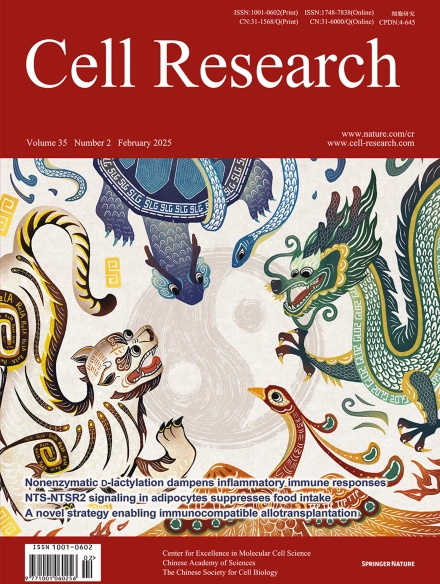
Advanced Search
Submit Manuscript
Advanced Search
Submit Manuscript
Volume 35, No 2, Feb 2025
ISSN: 1001-0602
EISSN: 1748-7838 2018
impact factor 17.848*
(Clarivate Analytics, 2019)
Volume 35 Issue 2, February 2025: 117-131 |
Neurotensin-neurotensin receptor 2 signaling in adipocytes suppresses food intake through regulating ceramide metabolism
Wei Fu1,2,3,4 , Yuanting Lai1 , Kexin Li1 , Yue Yang1 , Xiao Guo1 , Qifan Gong1 , Xiaofeng Zhou1 , Liying Zhou1 , Cenxi Liu1 , Zhi Zhang1 , Jisun So5 , Yufeng Zhang1 , Lin Huang1 , Guangxing Lu1 , Chuanyou Yi1 , Qichu Wang1 , Chenyu Fan6 , Chao Liu6 , Jiaxing Wang6 , Haiyi Yu6 , Yimin Zhao7 , Tao Huang7 , Hyun Cheol Roh5 , Tiemin Liu1 , Huiru Tang1 , Jianping Qi1 , Ming Xu6 , Yan Zheng1,* , He Huang1,* , Jin Li1,*
1State Key Laboratory of Genetic Engineering, School of Life Sciences, Institute of Metabolism and Integrative Biology, Human Phenome Institute and Zhongshan Hospital, Fudan University, Shanghai, ChinaNeurotensin (NTS) is a secretory peptide produced by lymphatic endothelial cells. Our previous study revealed that NTS suppressed the activity of brown adipose tissue via interactions with NTSR2. In the current study, we found that the depletion of Ntsr2 in white adipocytes upregulated food intake, while the local treatment of NTS suppressed food intake. Our mechanistic study revealed that suppression of NTS-NTSR2 signaling enhanced the phosphorylation of ceramide synthetase 2, increased the abundance of its products ceramides C20–C24, and downregulated the production of GDF15 in white adipose tissues, which was responsible for the elevation of food intake. We discovered a potential causal and positive correlation between serum C20–C24 ceramide levels and human food intake in four populations with different ages and ethnic backgrounds. Together, our study shows that NTS-NTSR2 signaling in white adipocytes can regulate food intake via its direct control of lipid metabolism and production of GDF15. The ceramides C20–C24 are key factors regulating food intake in mammals.
https://doi.org/10.1038/s41422-024-01038-8